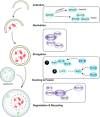Plant lectins, from ancient sugar-binding proteins to emerging anti-cancer drugs in apoptosis and autophagy
- PMID: 25488051
- PMCID: PMC6496769
- DOI: 10.1111/cpr.12155
Plant lectins, from ancient sugar-binding proteins to emerging anti-cancer drugs in apoptosis and autophagy
Abstract
Ubiquitously distributed in different plant species, plant lectins are highly diverse carbohydrate-binding proteins of non-immune origin. They have interesting pharmacological activities and currently are of great interest to thousands of people working on biomedical research in cancer-related problems. It has been widely accepted that plant lectins affect both apoptosis and autophagy by modulating representative signalling pathways involved in Bcl-2 family, caspase family, p53, PI3K/Akt, ERK, BNIP3, Ras-Raf and ATG families, in cancer. Plant lectins may have a role as potential new anti-tumour agents in cancer drug discovery. Thus, here we summarize these findings on pathway- involved plant lectins, to provide a comprehensive perspective for further elucidating their potential role as novel anti-cancer drugs, with respect to both apoptosis and autophagy in cancer pathogenesis, and future therapy.
© 2014 John Wiley & Sons Ltd.
Figures
Similar articles
-
Could plant lectins become promising anti-tumour drugs for causing autophagic cell death?Cell Prolif. 2013 Oct;46(5):509-15. doi: 10.1111/cpr.12054. Epub 2013 Aug 24. Cell Prolif. 2013. PMID: 24033443 Free PMC article. Review.
-
Plant lectins: potential antineoplastic drugs from bench to clinic.Cancer Lett. 2010 Jan 1;287(1):1-12. doi: 10.1016/j.canlet.2009.05.013. Epub 2009 May 31. Cancer Lett. 2010. PMID: 19487073 Review.
-
Plant lectins: targeting programmed cell death pathways as antitumor agents.Int J Biochem Cell Biol. 2011 Oct;43(10):1442-9. doi: 10.1016/j.biocel.2011.07.004. Epub 2011 Jul 20. Int J Biochem Cell Biol. 2011. PMID: 21798364 Review.
-
A Novel Molecular Model of Plant Lectin-Induced Programmed Cell Death in Cancer.Biol Pharm Bull. 2017 Oct 1;40(10):1625-1629. doi: 10.1248/bpb.b17-00363. Epub 2017 Aug 1. Biol Pharm Bull. 2017. PMID: 28768938 Review.
-
Plant lectins in cancer therapeutics: Targeting apoptosis and autophagy-dependent cell death.Pharmacol Res. 2019 Jun;144:8-18. doi: 10.1016/j.phrs.2019.04.001. Epub 2019 Apr 3. Pharmacol Res. 2019. PMID: 30951812 Review.
Cited by
-
Overview of the Structure⁻Function Relationships of Mannose-Specific Lectins from Plants, Algae and Fungi.Int J Mol Sci. 2019 Jan 10;20(2):254. doi: 10.3390/ijms20020254. Int J Mol Sci. 2019. PMID: 30634645 Free PMC article. Review.
-
Product safety aspects of plant molecular farming.Front Bioeng Biotechnol. 2023 Aug 8;11:1238917. doi: 10.3389/fbioe.2023.1238917. eCollection 2023. Front Bioeng Biotechnol. 2023. PMID: 37614627 Free PMC article. Review.
-
Effects of intragastrically-administered Tepary bean lectins on digestive and immune organs: Preclinical evaluation.Toxicol Rep. 2017 Dec 12;5:56-64. doi: 10.1016/j.toxrep.2017.12.008. eCollection 2018. Toxicol Rep. 2017. PMID: 29276690 Free PMC article.
-
Purification, Characterization and Bioactivity of a New Homodimeric Lectin From Vicia Altissima (Fabaceae) Seeds.Plant Environ Interact. 2025 Apr 2;6(2):e70047. doi: 10.1002/pei3.70047. eCollection 2025 Apr. Plant Environ Interact. 2025. PMID: 40182644 Free PMC article.
-
Exploring the Potential of Plant-Based Nanotechnology in Cancer Immunotherapy: Benefits, Limitations, and Future Perspectives.Biol Trace Elem Res. 2025 Mar;203(3):1746-1763. doi: 10.1007/s12011-024-04266-6. Epub 2024 Jun 11. Biol Trace Elem Res. 2025. PMID: 38862749 Review.
References
-
- Van Damme EJ, Lannoo N, Fouquaert E, Peumans WJ (2004) The identification of inducible cytoplasmic/nuclear carbohydrate‐binding proteins urges to develop novel concepts about the role of plant lectins. Glycoconj. J. 20, 449–460. - PubMed
-
- Liu B, Bian HJ, Bao JK (2010) Plant lectins: potential antineoplastic drugs from bench to clinic. Cancer Lett. 287, 1–12. - PubMed
-
- Mody R, Joshi S, Chaney W (1995) Use of lectins as diagnostic and therapeutic tools for cancer. J. Pharmacol. Toxicol. Methods 33, 1–10. - PubMed
Publication types
MeSH terms
Substances
LinkOut - more resources
Full Text Sources
Other Literature Sources
Research Materials
Miscellaneous






